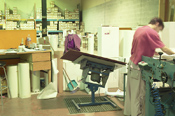
|
|
What is a control chart, and how is it used

A control chart, also called a Shewart or process behavior chart, is a tool that is used in manufacturing and other businesses to monitor processes and to assure that the processes remain stable. Walter Shewart discovered control charts in 1924 when he worked for Bell Labs. They were discovered because of Bell Labs need to reduce the frequency of failures and repairs to their equipment that was buried underground. Control charts are most often used in Six Sigma as a statistical tool. In Six Sigma the control chart is intended to assess the nature variation in a process, but it is also used to facilitate forecasting and management.
Control charts are actually one of the seven basic tools of quality control. They are used in conjunction with the histogram, Pareto chart, check sheet, cause and effect diagram, flowchart, and the scatter diagram. A control chart is used to help distinguish process variation due to assignable causes from those that are caused by causes that are out of their control.
|
|
In order to use the process chart correctly you will need to plot both types of process variations on the control chart. You want to make sure that you chart all of the causes because your assignable causes, which can also be referred to as special causes, play a huge role in the control chart. These types of processes are not always going to be present, in fact they are not considered normal. The reason for that is that special causes are causes that can be avoided, so if they show up on your control chart you will need to investigate. During your investigation, you will need to determine what you can do to prevent these causes from happening again. The other causes are considered common causes or even chance causes because of the fact that they occur by chance. Like special causes, these types of causes are not always present. Unlike special causes, though these factors are considered normal and are expected during a process because they are unavoidable.
Here is a look at the different elements that are going to be present on a control chart:
- Central line - drawn at the process mean
- Upper warning limit - drawn two standard deviations above the center line
- Upper control limit or the upper natural process limit - drawn three standard deviations above the center line
- Lower warning limit - two standard deviations below the center line
- Lower control limit or lower natural process limit - three standard deviations below the center line
- Process values - these are plotted on the chart. If all of these are plotted within the upper and lower control limits and no particular tendency is noted the process is considered to be stable or "In Control." If they are plotted outside the control limits or show a particular tendency they are not considered stable they are considered "Out of Control."
Here are the steps that you will need to follow to create a control chart.
Step one:
Select the process that you want to chart.
Step two:
Determine your process-sampling plan.
Step three:
Collect data from your process.
Step four:
Calculate the control chart specific statistics.
Step five:
Calculate your control limits.
Step six:
Construct your control chart using the software that you have chosen.
Other tips:
- If a point falls outside of the limits that have already been established for a given control chart, the people who are responsible for the underlying process are the ones who will need to determine whether a special cause has occurred. If one has, if possible the cause should be eliminated.
The one thing that you need to know is that in Six Sigma control charts are considered a necessary tool because of the role that they play. Control charts are used in assessing the nature of variation in a certain process. Not to mention that control charts also monitor existing processes to ensure that they remain stable, as well as help forecast improvement programs.
Privacy Policy, Terms of Use